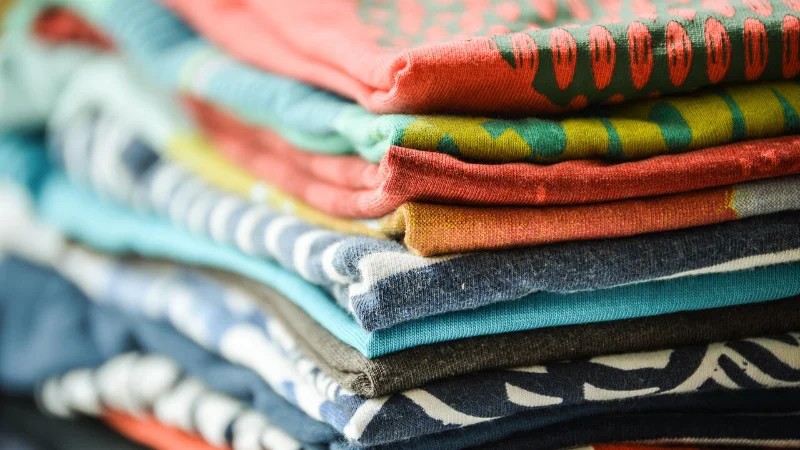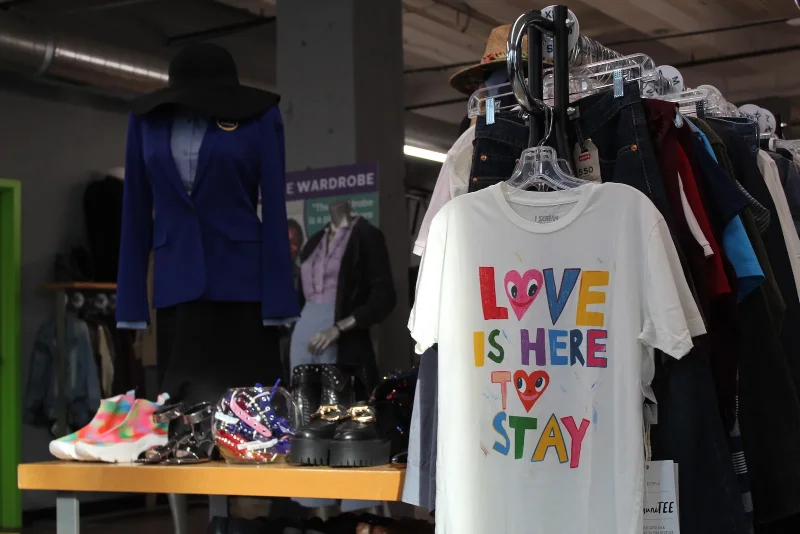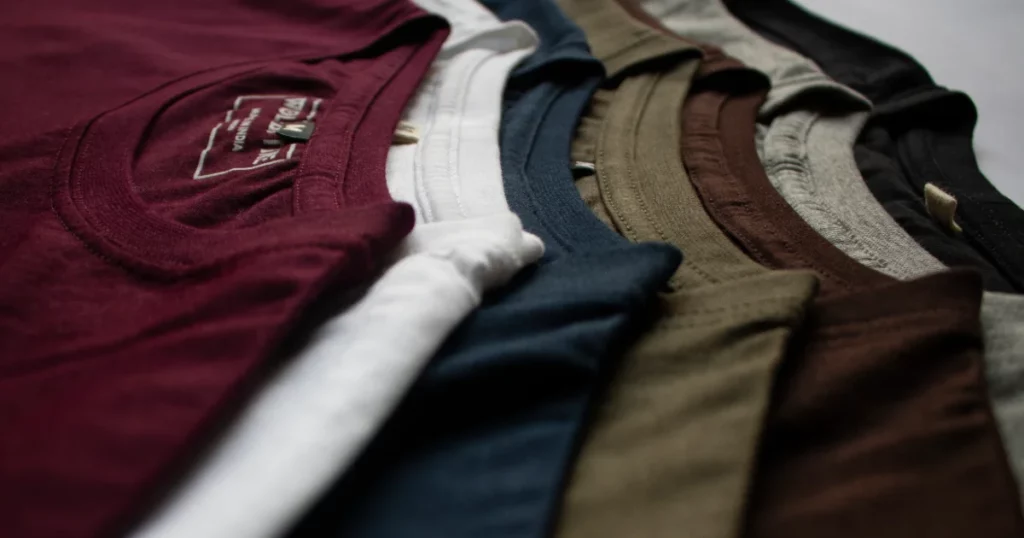No products in the cart.
Blog
How Many T Shirts Should I Own? Finding the Perfect Wardrobe Balance
How many t shirts should I own? The answer may surprise you: you don’t need more than 10. Whether you wear them daily for work or exercise, or if they’re just part of your casual wardrobe, finding the perfect t-shirt balance is essential.
In this article, we’ll explore the magic number for your t-shirt collection and offer insights into maintaining a functional wardrobe. Whether you’re a minimalist or a fashion enthusiast, these guidelines will help you make informed decisions about your t-shirt inventory and maintain a well-rounded closet.
How Many T Shirts Should I Own?
When building a functional wardrobe, one of the common dilemmas many people face is figuring out how many t-shirts they should have.
T-shirts are versatile and a staple in most closets, suitable for casual wear, layering, and even dressing up for certain occasions. However, the ideal number of t-shirts to own can vary depending on your lifestyle and clothing habits.
For those who wear t-shirts daily, such as for work or daily exercise, a practical guideline is to have around 10 t-shirts in your collection. This number allows you to have a fresh t-shirt for each day of a two-week cycle, and it aligns with a typical laundry schedule of doing laundry at least once every two weeks.
This approach ensures that you always have a clean and ready-to-wear t-shirt without the need for excessive quantities.

On the other hand, if you don’t wear T-shirts daily or have a more varied wardrobe, you can get by with fewer than 10 T-shirts. Owning a few versatile t-shirts you genuinely love and wear regularly can be more valuable than having a large collection of t-shirts that rarely see the light of day. Quality over quantity is a key principle in maintaining a functional wardrobe.
The number of t-shirts you should own depends on your personal preferences, lifestyle, and laundry routine. It’s about finding the right balance that ensures you always have a t-shirt ready when you need it without overcrowding your closet with unnecessary items.
Do You Have Too Many Clothes?
The Research
A recent study conducted by ClosetMaid sheds light on our clothing habits. Here are some key findings:
- The average woman deems 21% of her closet unwearable.
- 12% of the clothes in her closet have never been worn.
- 10% of individuals feel depressed when they open their closets.
- 33% admit to having clothes that are too tight.
- 24% have clothes that are too loose.
A whopping 44% can’t find an item in their closet at least once a month.
These statistics show that many of us have more clothes than we need and are struggling with disorganized wardrobes. So, how many clothes should you own?

It’s About Your Lifestyle
The number of clothes you need depends on various factors, including your lifestyle, budget, and career. It’s not about having a specific number but rather having the right clothes for your current situation. Ask yourself these questions:
- Do you often say, “I have nothing to wear”?
- Do you spend more than five minutes choosing an outfit in the morning?
- Do your clothes fit your current lifestyle?
- Do you have clothes for special occasions and everyday wear?
- Are you holding onto clothes for sentimental reasons?
- Do you have “skinny” or “fat” clothes for weight fluctuations?
- Do you feel depressed when getting dressed?
- Do you have clothes that need mending or altering?
If you answered yes to any of these questions, it’s time to reevaluate your wardrobe. The problem isn’t having too many or too few clothes; it’s not having the right ones for your current lifestyle.
The Three-Step Process for a Functional Wardrobe
Step 1: Weed Out Your Closet
Start by purging your closet of items that no longer serve you. Remove clothes that don’t fit, don’t align with your current lifestyle, or don’t make you feel good. This step includes removing sentimental items and clothes you haven’t worn in the past year.
Paring down your wardrobe may seem counterintuitive, but it aligns with the 80/20 rule. You wear 20% of your clothes 80% of the time. Removing unnecessary items lets you focus on the pieces you love and wear frequently.

Step 2: Organize Your Closet
Organize your remaining clothes by classification. Group similar items together, such as t-shirts, shirts, sweaters, jackets, dresses, pants, and skirts. Arrange them by color order, from light to dark. This organization makes it easier to mix and match outfits and see where you have gaps in your wardrobe.
Step 3: Purchase with Intention
When you need new clothes, list the items your wardrobe lacks. Whether it’s a crew-neck t-shirt to pair with a v-neck sweater or other essentials, shop with intention. This approach ensures you buy items that enhance your existing wardrobe, creating a coordinated and functional closet.
Following these steps, you can transform your closet into a collection of clothes you love wearing. Say goodbye to the morning struggle of choosing an outfit and welcome an organized, efficient, stylish wardrobe.
Tips for Sustainable Wardrobe Practices
In an era of fast fashion and ever-evolving clothing trends, we must consider the environmental impact of our wardrobe choices. Creating a sustainable wardrobe benefits the planet and promotes responsible consumer habits.
Here are some valuable tips to help you adopt sustainable practices in your clothing choices:
Buy Quality Over Quantity
Investing in high-quality, durable, well-made clothing pieces can significantly reduce your environmental footprint.

Instead of buying numerous cheap items that wear out quickly, opt for fewer, timeless pieces that can withstand the test of time. Quality clothing lasts longer, reducing the need for frequent replacements.
Embrace Secondhand and Vintage Shopping
Exploring secondhand and vintage stores is an eco-friendly way to expand your wardrobe. These items have a smaller carbon footprint since no new resources are used to create them. Plus, you can find unique and one-of-a-kind pieces that add character to your style.
Practice Responsible Maintenance
Proper care of your clothes can extend their lifespan. Follow care instructions, mend minor damages, and pay attention to stain removal techniques. Regular maintenance saves you money and reduces the need for constant replacements.
Focus on Versatile and Timeless Pieces
When shopping for new clothing, prioritize versatile items that can be mixed and matched to create various outfits. Classic, timeless pieces tend to stay in style longer, reducing the urge to follow fleeting fashion trends.
Reduce, Reuse, Recycle
Implement the “3 R’s” mantra: Reduce, Reuse, Recycle. Reduce your clothing consumption by only buying what you truly need. Reuse items by restyling or repurposing them to create new looks. When it’s time to part with clothing, consider donating or recycling them to divert textiles from landfills.
Choose Sustainable Fabrics
Opt for clothing made from sustainable fabrics such as organic cotton, hemp, or Tencel. These materials have a lower environmental impact than conventional cotton or synthetic fabrics. Supporting eco-friendly textiles encourages responsible production practices.

Support Ethical and Eco-Friendly Brands
Research and choose to support brands that prioritize sustainability and ethical manufacturing processes. Look for certifications like Fair Trade, GOTS (Global Organic Textile Standard), or OEKO-TEX, which indicate responsible and environmentally friendly practices.
FAQs
How Often Should You Buy T-Shirts?
The frequency of buying t-shirts depends on your individual needs and the condition of your current t-shirt collection. Ideally, you should purchase new t-shirts when existing ones show signs of wear and tear or no longer meet your style preferences.
Avoid unnecessary purchases by focusing on quality over quantity and choosing versatile t-shirts that can be worn in various outfits.
How Many Shirts Should Your Brand Start Off?
When launching a clothing brand, the number of shirts to start with varies based on your business plan and budget. It’s advisable to begin with a small, curated collection that showcases your brand’s identity and style.
Starting with 10 to 20 shirts in different sizes and designs allows you to gauge customer interest and gradually expand your offerings as your brand gains traction.

How Long Should You Keep T-Shirts For?
A t-shirt’s lifespan largely depends on its quality, how often it’s worn, and how well it’s maintained. A well-made t-shirt can last for several years if cared for properly.
As a general guideline, consider keeping t-shirts as long as they remain in good condition, fit your style, and continue to serve their purpose. Regularly assess your wardrobe and donate or recycle t-shirts you no longer wear.
What Is The 30-Wear Rule?
The 30-wear rule is a sustainable fashion guideline that encourages consumers to assess whether they will wear a clothing item at least 30 times before purchasing it. This rule promotes mindful shopping and discourages impulse buying.
Before adding a new garment to your wardrobe, ask yourself if you envision wearing it at least 30 times, ensuring that your purchases have a lasting and practical impact.
How Many Times Can I Wear A T-Shirt Before Washing It?
The number of times you can wear a t-shirt before washing it depends on various factors, including personal comfort, the t-shirt’s cleanliness, and your activities.
In most cases, t-shirts are worn daily, and non-strenuous activities can be worn 2-3 times before needing a wash. However, t-shirts worn during intense physical activities or in hot, humid conditions may require more frequent washing.
Using your judgment and washing t-shirts when they feel dirty or develop odors is essential.
Conclusion
In answer to the question, “How many t shirts should I own?” we’ve uncovered that the magic number typically hovers around 10. Whether your t-shirts are daily essentials or occasional fashion statements, the key is to strike a balance that aligns with your lifestyle and laundry habits.
By adhering to quality over quantity, curating a versatile collection, and following sustainable wardrobe practices, you can ensure that your t-shirt inventory complements your needs while minimizing clutter. Remember, it’s not about the quantity; it’s about having the right t-shirts that make you look and feel your best.


